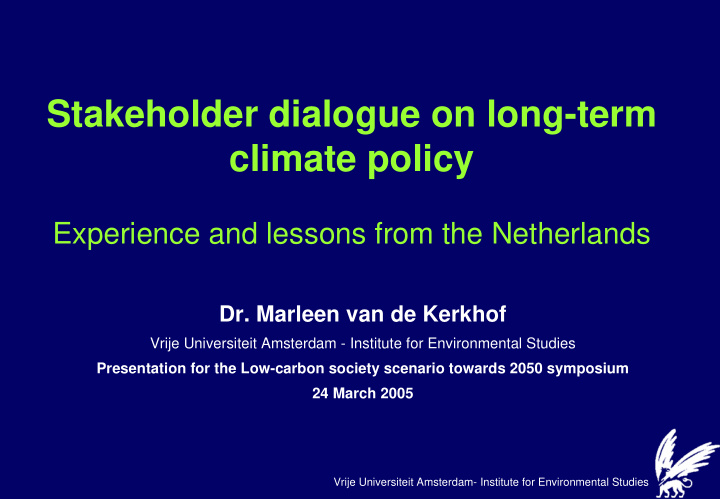



Stakeholder dialogue on long-term climate policy Experience and lessons from the Netherlands Dr. Marleen van de Kerkhof Vrije Universiteit Amsterdam - Institute for Environmental Studies Presentation for the Low-carbon society scenario towards 2050 symposium 24 March 2005 Vrije Universiteit Amsterdam- Institute for Environmental Studies
The Institute for Environmental Studies � Oldest academic environmental research institute in the NL � About 120 scientists and support staff � Multidisciplinary research � Participatory integrated assessments on climate, energy, water, hydrogen
Outline talk � Definition of stakeholder dialogue � The Dutch context for dialogue � Two dialogue examples: COOL and HOT � Pitfalls and factors for success � The Dutch model in Japan?
Definition of stakeholder dialogue � Scientists, policy makers and actors from society � Interaction and debate � Outcomes are advice to decision makers � Exploring preferences and value judgments with regard to policy options and targets � Focus on deliberation not negotiation � Consensus not necessary
Why stakeholder dialogue? � Climate change is a complex problem � Scientists can only make educated guesses � Preferences for targets, policy options and acceptability of risks always include value judgment � Value judgments and disagreements often insufficiently articulated � Generate support for climate policy
Typology of goals and methods for participation Mapping out diversity 2 Policy Scientists- Stakeholder Exercises workshop Focus Scenario Group analysis Participatory 1 Modeling Process Process as a goal as a means Citizens Juries Participatory Consensus Planning Conferences Reaching consensus (Van Asselt en Rijkens-Klomp, 2001)
The Dutch climate for dialogue � Netherlands are below sea level � Corporatism and consensus orientation � Negotiation and consultation institutionalized in environmental policy � Kyoto targets
Two dialogue examples: COOL and HOT � COOL - Climate OptiOns for the Long term Suppose we aim for 80% reduction of GHG emissions by the year 2050, what needs to be done to achieve this? � HOT - Helping Operationalize Article Two What are dangerous and non-dangerous levels of anthropogenic interference with the climate system?
The COOL project � Strategic insights for climate policy � Dialogue at three different levels � Four sectors of Dutch economy � A ‘What if’ exercise � 80% reduction by 2050 as working hypothesis � Exploration of different options
The COOL Dialogues Core Project Core Project National Dialogue European Dialogue Global Dialogue National Dialogue European Dialogue Global Dialogue Scientific support Scientific support team team
The COOL project � Strategic insights for climate policy � Dialogue at three different levels � Four sectors of Dutch economy � A ‘What if’ exercise � 80% reduction by 2050 as working hypothesis � Exploration of different options
Phasing of the National Dialogue Phase 2 (18m) Phase 1 (8m) Phase 3 (6m) The actual dialogue Preparation of Evaluation of - Future images dialogue the dialogue - Response options to - Interviews climate change - Content - Dialogue design - Criteria for climate - Process policy - Scientific input - Long-term policy strategy
Outcomes of the COOL dialogue � 80% reduction imaginable, but.. • In some sectors easier than in others • Moderate optimism about state of technology • Technologies that are needed are also controversial • Doubts about the social acceptance of the required policies • Strong government needed � Business companies recognize need for action � Need for consistent government policy � Dialogue appropriate tool to mobilize stakeholder knowledge
The HOT project � Dialogue to further articulate Article 2 of the UNFCCC � Discuss acceptable and unacceptable climate change impacts � Develop indicators for ‘dangerous levels of climate change’ � Dialogue is not negotiation
Article 2 of the UNFCCC The ultimate objective of this Convention and any related legal instruments that the Conference of the Parties may adopt is to achieve, in accordance with the relevant provisions of the Convention, the stabilization of greenhouse gas concentrations in the atmosphere at a level that would prevent dangerous anthropogenic interference with the climate system. Such a level should be achieved within a time-frame sufficient to allow ecosystems to adapt naturally to climate change, to ensure that food production is not threatened and to enable economic development to proceed in a sustainable manner
Phase I of the HOT project Understand what is/are : � Key issues in Article 2 � Main knowledge gaps � Importance of Article 2 � Need for dialogue � Potential indicators for dangerous climate change Activities: � Questionnaires in the four regions � Four regional workshops
Outcomes of HOT Phase I Examples of indicators � Water Availability of drinking water, rainfall variation, frequency of flooding and droughts, ice sheet stability � Food Area suitable for agriculture, tons of food production, productivity of a specific crop � Biodiversity No. of exotic and native species, migration of species, frequency of corral bleaching, sea level rise, glacier retreats, impacts of extreme events � Health Mortality, risk exposure, environmental risks
Pitfalls for the dialogue approach � Lack of policy support � Lack of urgency of the problem � Hierarchies and power issues � Not all relevant parties want to participate � Different levels of knowledge � Ambitions too high
Factors for a successful dialogue � Create a sense of urgency � Gain political support for the process � Good preparation is crucial � Get people’s trust and commitment � Create atmosphere of openness and learning � A series of workshops to create continuity � Give ownership to the participants � Be clear about the ambitions of the process
The Dutch model in Japan? � Sense of urgency high � Japan made huge efforts for the Kyoto negotiations � Stakeholder approach less common in Japanese climate policy � Differences seem to be huge, but have these been sufficiently articulated? � Dialogue can mobilize stakeholder knowledge for Japanese climate policy
Recommend
More recommend